Appetizers
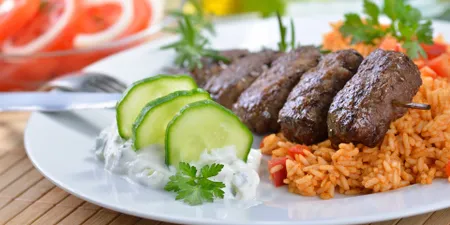
Cevapcici With Tzatziki Dip
Cevapcici[che VOP chee chee] comes from the Persian kebaband Slavic diminutive ending, -cici; literally, “little kebabs.” These small sausages were introduced to Europe during the Ottoman Empire. Popular in Balkan countries, these bite-sized treats are enjoyed as appetizers or with tzatziki in a sandwich, and can be cooked under the broiler or barbecued.

Corn Maque Choux
This dish of fresh corn with trinity vegetables and Cajun seasonings is traditional Acadian French fare. If you cannot find tasso ham, just use smoked sausage, country ham or bacon. This version is a robust side dish, perfect with blackened fish; or you can add crawfish, shrimp, crab or toasted okra to serve it as a main dish.
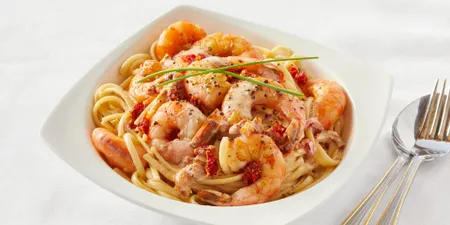
Creamy Cognac Prawns
Try this recipe to share the taste of France with friends and family. It is a delicious mixture of shrimp sautéed with shallots and sundried tomatoes in a creamy Cognac sauce. Excellent served with pasta or over rice, add a light salad to offset the richness, and a side of warm, crusty bread.

French Gougères
Gougères are among the most popular hors d’oeuvres in France. A traditional specialty of the Burgundy region, gougères are often made with Gruyère cheese. You can also use other cheeses (such as parmesan) to add an extra depth. Enjoy these with a glass (or two) of good French wine.
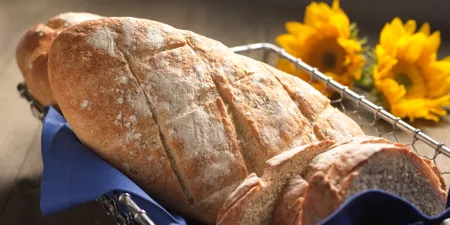
Pain de Campagne
This French country bread is a rustic loaf, typically a large round loaf. The technique below involves making a sponge first, which contributes a depth of flavor to the bread. Misting the bread once in the oven is a great technique for home bakers to achieve that hard, crackly crust so typical of good French bread.
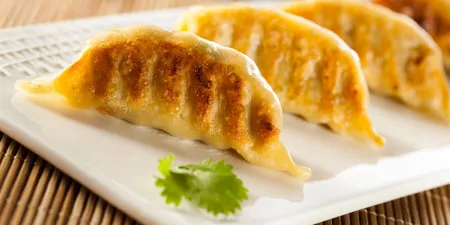
Pot Stickers
These delicious little Chinese dumplings are a traditional treat during Chinese New Year, filled with meat or vegetables, then cooked by steaming, poaching or frying. Consider doubling or tripling the recipe and freezing some (uncooked) for a great “go-to” fast meal—just drop them into hot broth, add a few veggies, and you have a hearty, warming soup.
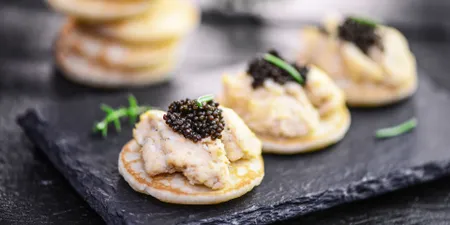
Russian Blini
This traditional Russian dish is somewhat like pancakes or crêpes, but made with a yeast dough that is allowed to rise. Buckwheat, a staple flour of colder climates, is typically incorporated. Often, the blini are made bite-sized and served with a variety of toppings from savory caviar and smoked salmon to sweet cream and fruit for a dessert.

Rustic Fried Green Tomatoes with Cajun Beurre Blanc
Summertime brings everyone’s favorite treat—homegrown tomatoes. However, invariably a few at the end of the season do not ripen, and this is a delicious way to use these unripe fruits. Our version of this true Southern classic takes fried green tomatoes to a whole new level, pairing a Cajun-spiced cornmeal crust with a cream sauce and poached crawfish.
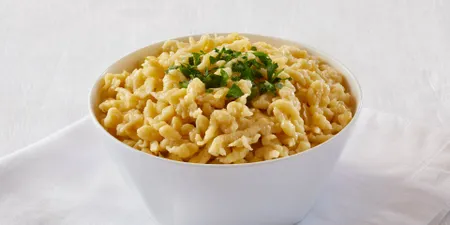
Spätzle
These delightful dumplings are favorites of southern Germany; their name comes from Swabian dialect and means “little sparrows.” They are indeed delicious little bites in any language. Here, we have improvised how to shape them so you can try them at home—just use a colander with fairly generous-sized holes. These are also outstanding with cheese and bacon.
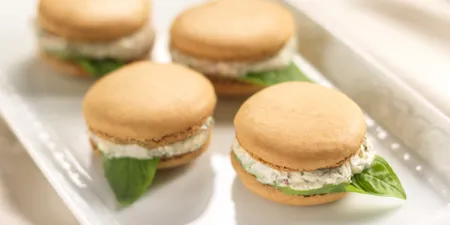
Tomato-Feta-Basil Macarons
Surprise your friends with this savory macaron, a twist on the traditionally sweet cookie with its mild crust and tangy center of feta, fresh tomatoes and basil. When you assemble them, be sure to spread the filling gently or even use a piping bag to prevent damaging the delicate meringue cookies.
Soups

Beef Pho
Pho (pronounced like “fun” without the “n”) originated in northern Vietnam during the early 20th century and was likely brought by Chinese refugees who settled around Hanoi at that time. Making the base from scratch yields outstanding results but takes time; alternately, substitute 3 quarts quality beef broth, add seasonings, simmer for 1 hour; strain and proceed.
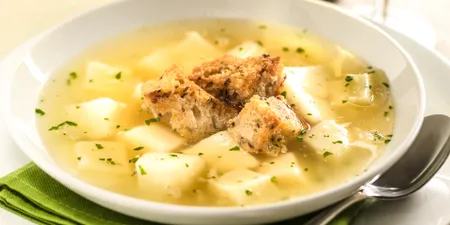
Česnečka
According to Czech lore, Česnečka(garlic soup) will cure just about anything, even the common cold. It certainly tastes rich and comforting. So, if you feel under the weather, make a big pot of this simple soup of broth, potatoes, garlic and cheese to help you feel better.
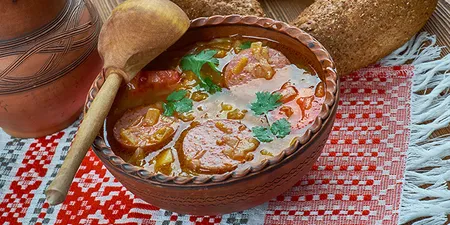
Ciorba De Varza
Ciorba de Varza (pronounced “CHOR ba duh VAR zuh”) is a traditional cabbage soup with meatballs, very typical of the Bulgaria/Romania region, and uses both fresh and fermented cabbage (sauerkraut). Hearty and filling, this soup absorbs the richness of the beef meatballs as they cook in the chicken broth, developing complex flavors and depth.

Cream of Chanterelle Soup with Arugula
The chanterelle, or the girolleas it is called in France, is a gold, spongy, trumpet-shaped mushroom with a distinctly nutty flavor. Chanterelles have a short growing season. These fungi taste best when just harvested and still plump. Delicious as a side dish, lightly sautéed, they are also wonderful in soups or served over pasta.

Creamy Tomato Soup with Truffle Oil
Warm and rich, this soup can be made in under half an hour for quick, delicious comfort food, and the dash of savory truffle oil adds a decidedly European touch. This sophisticated soup is perfect for a cold winter night or as an elegant luncheon starter.
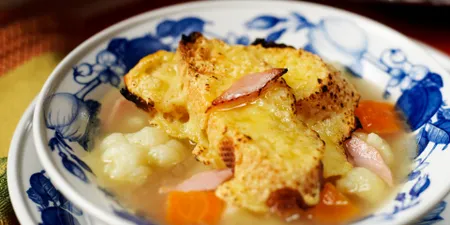
Dutch Cheese Soup
The Dutch are great soup eaters, often featuring soup as a main dish. This hearty soup, enriched with Gouda cheese, is perfect served piping hot on a chilly evening. Gouda is the quintessential Dutch cheese to use: a young Gouda will give you a soft, mild taste, while an aged one will provide more complex and robust flavor.
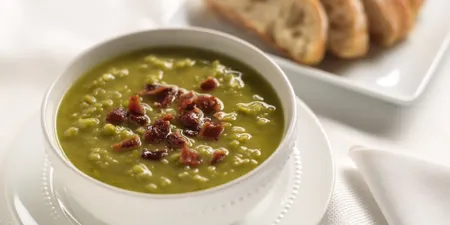
Dutch Split Pea Soup
Healthy, hearty and packed with flavor, this Dutch version of split pea soup (known as snert), is one of the signature dishes of the Netherlands. During cold winters, small food and drink stalls called koek en zopie spring up along frozen canals serving snertto ice skaters. It is a real treat and easy to make.
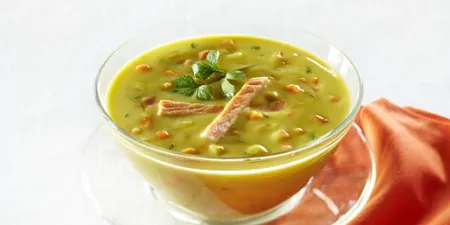
Ertesuppe (Split Pea Soup)
Beloved across the Twin Cities region of Minnesota, split pea soup is actually one of Norway’s many culinary imports. Our version of this perennial favorite makes a hearty lunch or dinner, ideal for fall or winter days. The combination of ham and chicken broth creates a flavorful soup. Split peas did not appear until the end of the 19th century, when a process for removing the skins became common—the peas split naturally when their skins are removed.

French Onion Soup
This classic soup can be simply outstanding when made with a hearty homemade beef stock or broth, but in a pinch, purchased broth will still make a very good soup. The key to the dish is ensuring the onions caramelize well but do not burn.
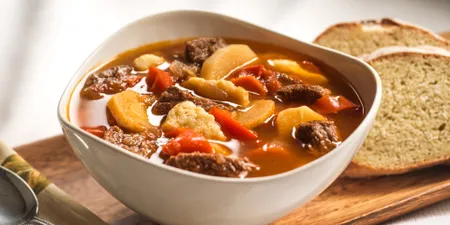
Hungarian Goulash
Goulash originated with Hungary’s herdsmen and quickly spread throughout Europe. It is a soup, but its rich combination of ingredients makes it a meal on its own. The long simmering time ensures the meat is tender and flavorful, and the csipetke dumplings are a delightful addition.
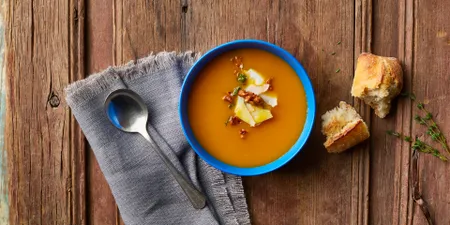
Pumpkin Soup
Since the first pumpkin seeds were brought to the Old World from the Americas, Europe has embraced squash-based cuisine. This easy recipe yields a full-bodied soup without using cream. The final flourish of candied walnuts, thyme and parmesan adds texture and complements the flavors exquisitely, and makes for a delightful seasonal fall starter or winter main course.
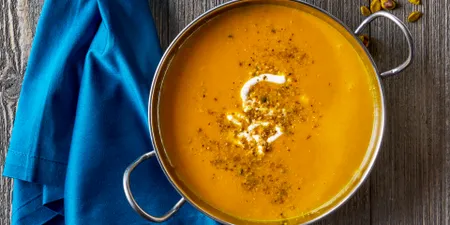
Roasted Carrot Soup
The nutty, spicy seasoning of this hearty soup combined with yogurt topping gives it a unique and irresistible flavor. Made with toasted and grinded nuts and seeds, peeled carrots and chicken stock, it is easy to prepare. This sweet, nourishing and filling soup and will help keep you warm when it gets chilly.
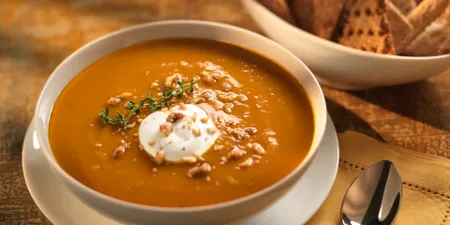
Roasted Pumpkin Soup
The sugar pumpkin called for in this recipe is a cooking variety; dense with meat, tender and perfect for cooking and baking, it is an excellent source of vitamin A. When you purée the soup, remove the center cap from the lid, covering the hole with a towel to allow steam to escape—this prevents the lid from popping off.
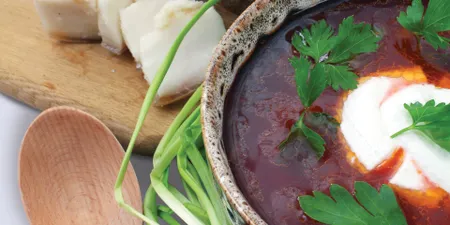
Russian Borscht
This beet soup is a staple of Russia and eastern Europe. Thought to have originated in Ukraine, its name is derived from Yiddish. There are as many recipes as there are cooks: it can be thick and hearty or clear and light; served hot in winter or cold in summer. This hearty version is made with beef stock.

Wisconsin Beer Cheese Soup
Wisconsin, home of so many cheeses, is the inspiration for this hearty soup that highlights bock beer and two kinds of cheddar, with its traditional garnish of popcorn and chives. Be sure to use sharp, good-quality cheeses and bock beer—the strong, dark lager’s maltiness creates a depth of flavor you will not get with a lighter beer.
Salads

Green Papaya Salad
In Cambodia, this is called Bok Lahong (“pounded papaya” in Khmer); in Vietnam, Goi Du Du (pronounced “guy dodo”); and in Thailand, it is known as Som Tam. However you say it, this delicate combination of contrasting flavors is refreshing and delicious. If you use all the chilies, this dish can be spicy, so feel free to adjust to your taste.
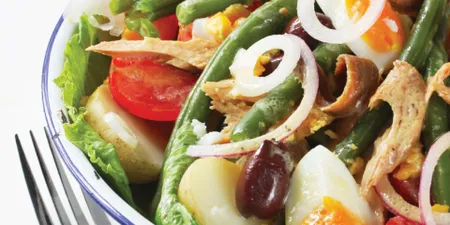
Salade Niçoise
This salad’s name, pronounced “sah LAHD nee SWAHZ,” reflects its origin of Nice, France. The ingredients—particularly tomatoes, capers and olives—also harken back to the flavors of sunny Provence. Enjoy this hearty salad, substantial enough by itself for a lunch or light dinner, with a glass of chilled white wine and a crusty French epi or baguette.
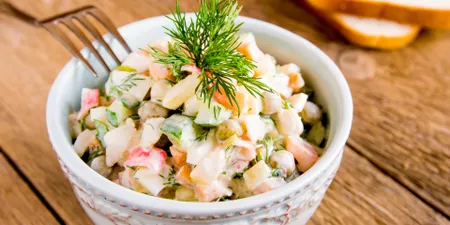
Stolichny Salad
This Russian dish, often served on New Year’s Eve, and also known as Olivier Salad, was invented in the 1860s by Lucien Olivier, chef of Moscow’s celebrated Hermitage restaurant. It became the restaurant’s signature dish—a blend of vegetables, chicken and two popular Russian staples, sausage and sour cream. Doktorskaya (“doctor sausage”) is so named because of its exceptionally nutritious meat.
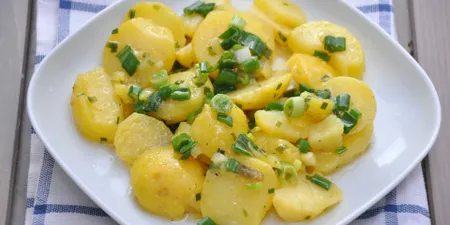
Viennese Potato Salad
This recipe employs beef broth, a typical ingredient that is the backbone of Viennese cooking. Beef broth and stock are used in Viennese cuisine for soups as well as basting. Red or Yukon gold potatoes tend to work best for this salad, because their waxy texture holds up well. For variety, you can also add thinly sliced pickles.
Main Courses
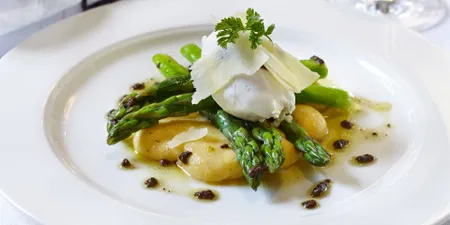
Asparagus & Polenta With Truffle Dressing
Treasured since ancient times, truffles are among the world’s great delicacies. Most come from Europe, and they are famously abundant and delicious in France’s Périgord region. Here, just a small amount of this aromatic fungus complements the hearty polenta and offsets the delicate, grass-like asparagus with its earthy, delectable flavor.
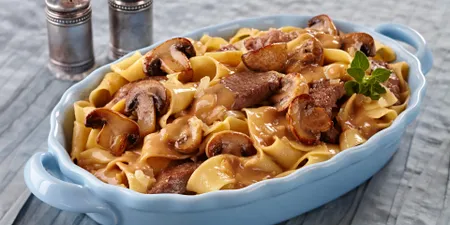
Beef Stroganoff
This hearty main dish originally came from 19th-century Russia and was named for the Stroganov family, whose palace can still be seen on Nevsky Prospekt in St. Petersburg. In the early versions of the recipe, mustard was included as an ingredient, but modern versions omit the mustard and instead depend on the rich texture of sour cream.

Beer Battered Walleye
Native to the Upper Mississippi River basin, walleye are beloved throughout the region for their delicate taste and exquisite texture. Minnesota’s Red Lake is particularly prized by anglers for its abundance of the carnivorous freshwater fish. Our recipe marries this local specialty with another of the region’s culinary treasures: beer, which is used in both the sauce and the batter.
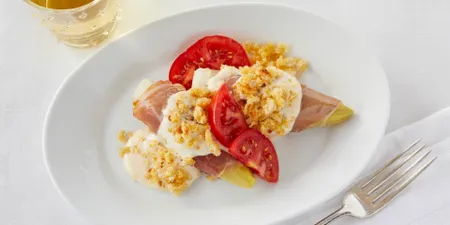
Belgian Endive & Ham Au Gratin
So valued is the Belgian endive by Belgians that they refer to it as “white gold.” A tad bitter when raw, the sleek, compact heads mellow in flavor when cooked. This elegant dish of ham and Belgian endive broiled in a rich cheese sauce is a perfect cold weather dish as well as a great accompaniment for fish.
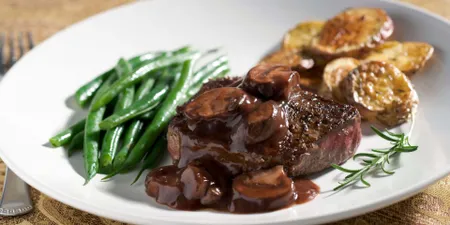
Bordelaise Sauce
Bordelaise [bore duh LAZ] sauce is a great accompaniment for any grilled red meat, and Bordeaux wine is the key to this recipe’s rich taste. The author of this classic recipe is Georges Auguste Escoffier; it appears in his book Le Guide Culinaire, first published in French in 1903, which has become a classic on the art of cooking.
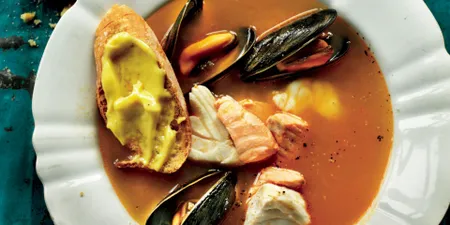
Bouillabaisse Toulonnaise
Originally cooked by fishermen using unwanted fish from their catch, this traditional Provençal fish stew is served with a creamy, saffron-scented rouille.
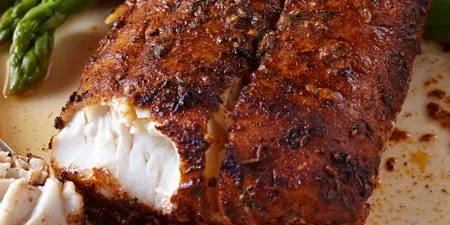
Cajun Blackened Redfish
This dish is now considered a classic, but it was Chef Paul Prudhomme who brought the blackening technique to mainstream dining in Louisiana, along with a number of other inspirations. Be sure to use a very hot cast iron skillet and do not overcook your fish; it is the browning of the butter combined with the spices that makes for delicious results.
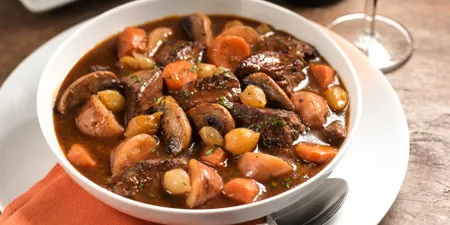
Carbonnade à la Flamande
Winter is the perfect time to make hearty meals that raise everyone’s spirits. Unlike French stews made with wine, this Flemish carbonnaderelies on the flavor of Belgian abbey-style beer. The key to making it great is the beer: we recommend Oud Bruin, an aged Belgian beer. If you cannot find this, a stout or porter works well too.
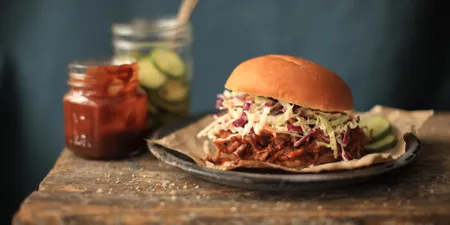
Chopped Pork Sandwich
This classic comfort food is a staple along the banks of the Lower Mississippi. The practice of slow-cooking cuts of meat to bring out their heavenly textures and succulent flavors was well established in the American South by the 19th century. Memphis especially is renowned for its pulled pork, which is seasoned to create a perfect balance of sweet and savory notes.
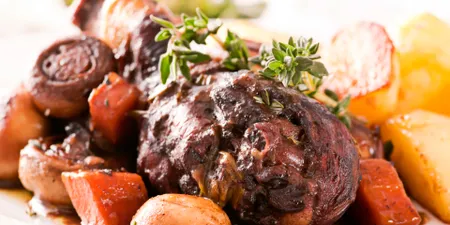
Coq Au Vin
Coq au Vin is a traditional French chicken dish cooked in full-bodied Burgundy wine. This rich, tasty entrée is often served during the colder months of the year. While relatively simple to prepare, it will impress and delight your guests. The secret to the depth of flavor is marinating the chicken.

Dutch Hutspot
These vegetables (hutspot) with braised beef (klapstuk) are part of an annual celebration commemorating the 1574 end of Leiden’s siege during the Dutch revolt against Spain. In a shrewd maneuver, the Dutch punctured their dikes, flooding the Spanish position and thus freeing Leiden. Liberators brought herring, bread and hutspot, which residents still eat today.

Flammkuchen
Flammkuchen, which literally translates from German as “flame cake,” became popular in the 1960s at the beginning of the pizza craze. You will find variations of it in much of Europe. With both a thinner crust and topping layer than a typical pizza, it is perfect served with a generous side salad for lunch or a light supper.
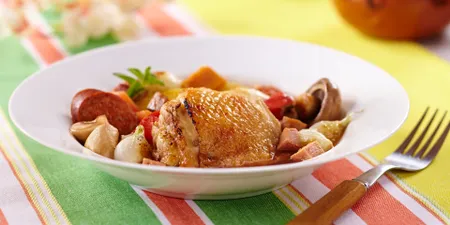
Frango Na Púcara
Looking for something different for dinner? This hearty, slow-cooking chicken entrée is easy to make and features an interesting blend of flavors. The recipe comes from the city of Alcobaça on Portugal’s west coast; traditionally it is prepared in a special clay pot called a púcara, but you can use any covered baking dish.
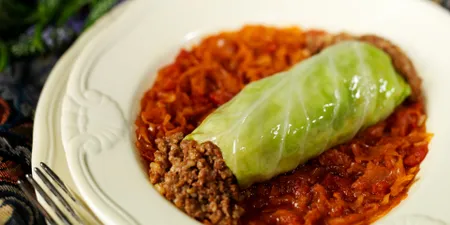
Hungarian Cabbage Rolls
Paprika comes in five grades of pungency: from the dark red and mild “delicacy” paprika to the very pungent light red “rose” paprika. In Hungary, paprika is not a garnish but rather an integral part of the dish. Try this delightful celebration of paprika and see why it is Hungary’s national spice.

Korean-Style Lamb Chops
This fiery dish is a satisfying, intense entrée and tastes great paired with rustic mashed potatoes, flash-fried asparagus or long beans. If you prefer a little more heat, try Korean chili paste in place of the chili garlic sauce. Either way, this dish is a true delight.
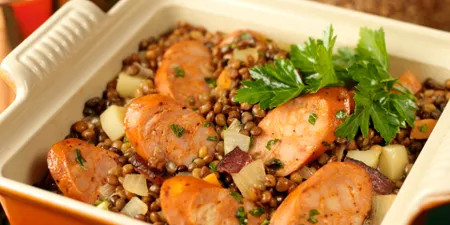
Linseneintopf (German Lentil & Sausage Stew)
The literal translation is “lentil pot” (linsen+ eintopf), but the recipe results are magic. Chock-full of sausage, bacon and veggies, this hearty stew is a welcome winter meal. This German dish can cook largely unattended, with just an occasional stir once it gets going, and makes a substantial meal served with warm, crusty bread.

Louisiana Jambalaya
A slow simmered dish highlighting the wonderful flavors of the bayou, Jambalaya is believed to be an adaptation of Spanish paella (using local ingredients) by early Louisiana settlers. If you can find andouille sausage, it adds an authentic flavor. You can also substitute crawfish or shrimp for chicken—just stir in at the end, cooking just until it is opaque.
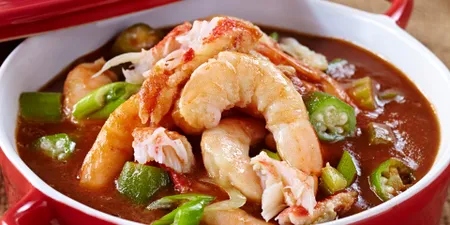
Louisiana Seafood Gumbo
This seafood and andouille medley is quintessential Louisiana fare. Serve it as an appetizer with French bread, or with rice for an entrée. The oil-based roux is a traditional thickener. Offer additional hot sauce for those who like it spicy. Add filé at the table, as gumbo can become bitter if it is added during cooking.

New Orleans BBQ Shrimp
New Orleans flavors tease you with a confluence of smoky spices, Worcestershire, lemon and a copious amount of hot sauce–laced, butter-bathed gulf shrimp in this Southern appetizer. Delicious on its own, it is even better served with crusty hot French bread to mop up every drop of sauce. Be sure to have plenty of napkins on hand.

New Orleans Red Beans And Rice
Traditionally, this dish was served on Mondays in New Orleans, both to utilize any ham bones left over from Sunday’s dinner and because it required little attention while cooking. Thus, it freed up the lady of the house for the other chores at the week’s start. Here we use a ham shank, and layer the depth of flavor with the addition of tasso ham and andouille.
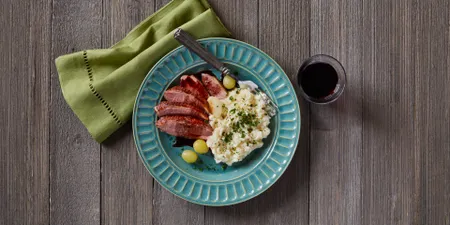
Prague Duck
Garnished with thyme and served with onion confit, this quintessential regional dish is delightful to prepare at home for a small gathering. Be sure not to overcook the duck breast—it should still be rosy in the center.

Ratatouille
This classic Provençal stewed vegetable dish is multitalented—able to act as a flavorful base for grilled meats, an excellent side dish for poultry, or a main course for vegetarians. It also is versatile enough to be served hot, room temperature or cold, and even makes a lovely sandwich filling that can be augmented with cheese for a substantial lunch.

Shrimp Étouffée
Shrimp are “smothered” in this rich Creole sauce; the French adjective étouffée literally means smothered or suffocated—a traditional cooking method of Creole and Cajun cuisine. The multitude of spices and seasonings in this creates an incredible depth of flavor, complementing the shrimp, and provides a satisfying and hearty meal.
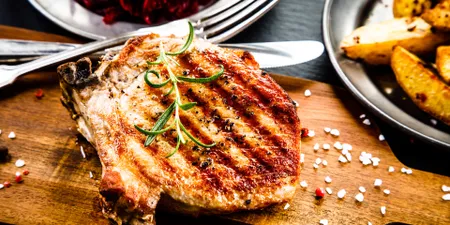
St. Louis Pork Steaks
First popularized by a local St. Louis grocery chain during the 1950s, these thinly sliced pieces of pork shoulder are a hallmark of outdoor grilling throughout the American heartland. The “Gateway to the West” is also known for its unique style of BBQ sauce, boasting a bewitching blend of sweet and tart flavors set off by a mild spiciness.

Three-Alarm Firecracker Chicken
With fresh jalapeño, dried chilies and chili garlic sauce, this dish is definitely hot and spicy! If you prefer, de-seed the jalapeño and dried chili to cut the heat some. This dish really provides a kick to the classic protein of chicken breast, and the stir-fry cooking method means it comes together in a snap.
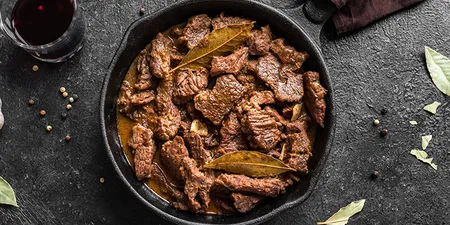
Viennese Beef Goulash
This Austrian beef stew with paprika and caraway seeds is a standard in Salzburg pubs and Viennese coffeehouses. Served over noodles or potatoes, it’s hearty, warm and filling. While the ratio of onion and garlic to meat may surprise you, these cook down to form a savory sauce, and we are certain this dish will become one of your favorites.

Wiener Schnitzel
This classic recipe comes to us from Austrian Master Chef Toni Mörwald, proprietor of Vienna’s Michelin-starred restaurant, Mörwald Gourmet “Toni M.” It is traditional, simple to make and delicious. This dish itself is a classic of Vienna, although it originates from Milan, as Field Marshal Radetzky is said to have brought a “cotoletta Milanese” recipe back to Vienna in 1848.
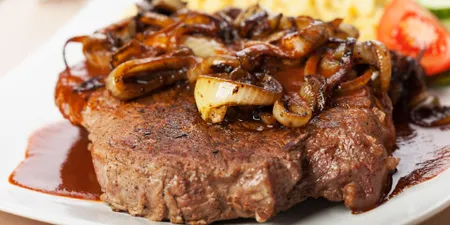
Wiener Zwiebelrostbraten
Wiener Zwiebelrostbraten might not exactly roll off your tongue, but it will melt in your mouth. The name, pronounced VEE-ner TZVEE-bell-roast-brotten, literally means “Viennese roast beef with onions.” Very popular in Austria and Bavaria, this recipe enhances the beef flavor of the sirloin steaks through slow oven braising with that staple of Viennese cuisine, beef stock.
Desserts

Almond Cake
This fine, light cake is a favorite from one of our Dutch friends, who used to make it frequently and served it with coffee as an afternoon pick-me-up. Here we use a springform pan, but for a more elegant presentation it can also be baked in a shaped pan, such as a Bundt.

Alsatian Apple Tart
With its graceful fan of apple slices enrobed in creamy vanilla custard, this tart is a dessert classic of the small but esteemed region of Alsace, France. Bordering Germany and Switzerland, Alsace is known for its high-quality cuisine that reflects a mix of German and French influences. Try this delicious tart for a small taste of this region.
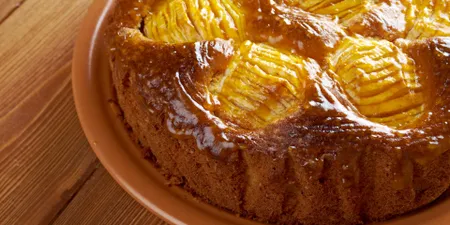
Apfelkuchen
Cooking one of Germany’s favorite sweet treats at home is a great way of sharing your holiday travel discoveries and memories with friends and family. For a taste of the old country, follow this easy recipe for traditional Apfelkuchen, then make a pot of coffee and enjoy a warm slice of cake with whipped cream.
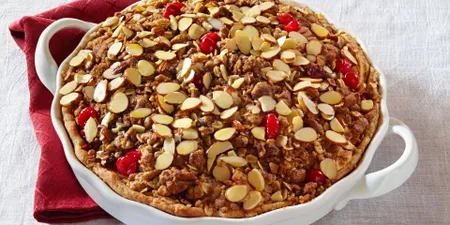
Apple Cranberry Tart
Here is one of the recipes we have collected while traveling through France. The almond paste, an ingredient often used in French baking, gives this delicious dessert a Continental flavor. With its combination of fresh apples and cranberries, plus easy crumb topping, this will quickly become one of your favorite fall desserts.

Apple Strudel
Made popular in the 1700s by the Hapsburg Empire, today apple strudel is considered the national dish of Austria. The oldest strudel recipe on record, handwritten in 1696, can be found at the Viennese City Library.

Basel Brunsli
Brunslioriginate from Basel, and literally means “brown cookie” from the German, brun Guetsli. A recipe for these first appeared in the cookbook The Sweet Basel in 1750, and today the cookies are eaten all over Switzerland during the holiday season, usually served with Mailänderliand cinnamon stars.

Bread Pudding With Warm Bourbon Sauce
This Southern bread pudding is rich and elegant, with the distinctive taste of Steen’s cane syrup. Bourbon, another American flavor, is woven throughout both the pudding and the sauce. Bourbon came under heavy regulation in 1897 with the Bottle in Bond Act, which required the spirit to be made from only one distillation season, one distiller and one distillery.
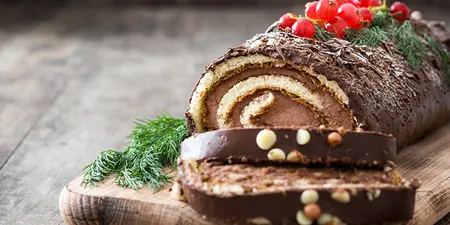
Bûche De Noël
This grand dessert is a descendant of the medieval subtlety—food disguised to look like something else. Here, chocolate cake masquerades as the traditional yule log for a long winter’s night. Although making the log look realistic can be challenging, even a simple approach is great fun to make and delightful to serve on a holiday evening.

Bulgarian Rice Pudding
This oriz puding is easy to make and likely will become a favorite. The lemon zest adds a freshness to the pudding, and the rose-pistachio garnish is lovely. You can serve this while still warm, or at room temperature; just refrigerate any leftovers.
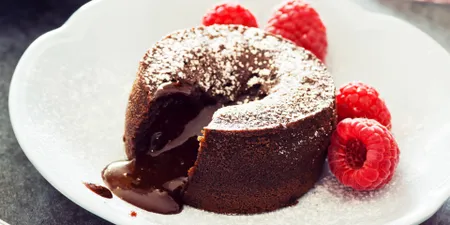
Chocolate Lava Cake
This rich dessert combines a soufflé with the decadence of molten chocolate. It is every chocolate lover’s ultimate dream, with crusty cake edges and a gooey, soft center. The cake batter can be frozen for up to a month before baking (do not thaw before baking). Offset the richness by garnishing with crème fraîche and fresh raspberries.

Chocolate Macarons
French macarons (from the Italian maccherone, or meringue) are typically a sweet meringue confection filled with preserves, caramel or buttercream; these chocolate ones are a light-as-a-feather French treat. The sugar syrup method results in a delicate, delicious meringue subtly flavored with almonds, and the filling is intensely rich and decadent.
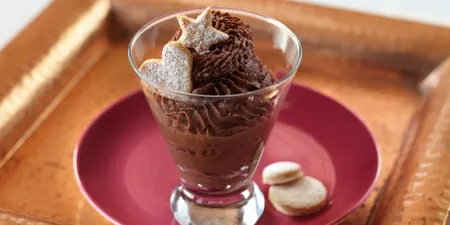
Chocolate Mousse
Simple and elegant, this is the quintessential French dessert. When you travel to France, no matter the region, you will likely be offered this “chocolate foam” (moussemeans “foam” in French). Rich, creamy, dark and dreamy, chocolate mousse is not only a perfect gourmet treat, it also one of the simplest to make.

Chocolate Truffles
Delightfully easy to make, these chocolate truffles are a fabulous holiday gift. Rich and decadent, they can be a dessert unto themselves, or an excellent accompaniment to an espresso. Be sure to use a good quality of chocolate as the flavor of the final candies will be dependent upon this.
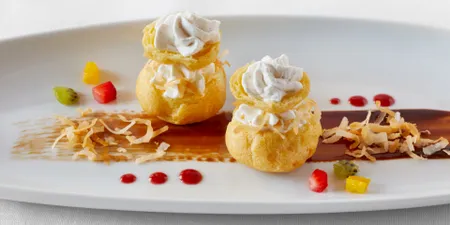
Coconut Profiteroles
The term profiteroleis believed to have come from the French verb profiter, to profit, and originally meant a small gratuity or gift such as one might give to a servant. This rendition, with fresh fruit, coconut purée and toasted coconut, mascarpone and cream, is indeed a fine gift to the taste buds.

Flourless Chocolate Cake
This dense moist cake is like a giant chocolate truffle—crunchy on top with a deliciously fudgy center. Extremely rich yet so simple to make, it is popular all year round. It is gluten-free and you can even make it in advance—just take it out of the refrigerator an hour before serving. It tastes even better the second day.

French Pear Tart
Frangipane, a sweet almond-flavored pastry cream, sets off this tart’s buttery pastry and slices of fresh pear. Like so much of French cooking, this dessert is both elegant and delicious. Indeed, while all aspects of French gastronomy are renowned, it is France’s wonderful pastries and baked goods that are typically the most beloved.

Fruit Butter
This recipe makes a slightly tart fruit butter that is a wonderful complement to toast, pancakes or muffins. If you want a sweeter butter, replace the cranberries with golden raisins.

Lebkuchen
Spiced and nutty in flavor, these traditional German Christmas cookies are a form of gingerbread. The best-known are Nürnberger Lebkuchen, which are often presented in ornately decorated tins or boxes. These cookies are the modern descendants of medieval gingerbread, which was typically a combination of spices, honey and dried bread crumbs.
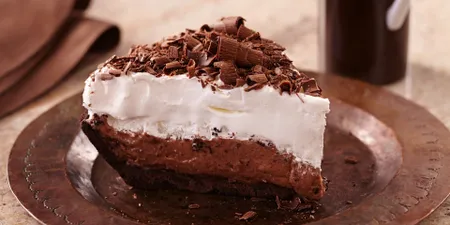
Mississippi Mud Pie
This pie is pure decadence, with chicory coffee ice cream, fudge brownie cake, Oreo cookie dust and a drizzle of chocolate sauce topped with candied pecans and whipped cream. This is a spectacular treat for special occasions that celebrates the best of sweet Southern flavors. Of course, if you prefer, you can make your brownies from scratch.
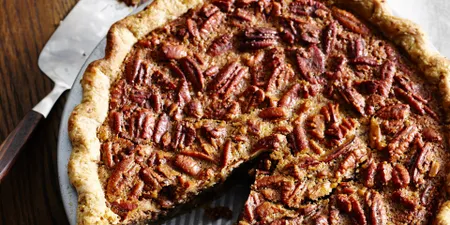
Molasses Pecan Pie
With its warm, damp climate, the Lower Mississippi area has historically proven to be ideal for cultivating pecans, a native North American tree nut. Recipes for pecan pie began appearing in the American South during the late 19th century, and today the sweet treat is hailed as one of the region’s signature desserts.
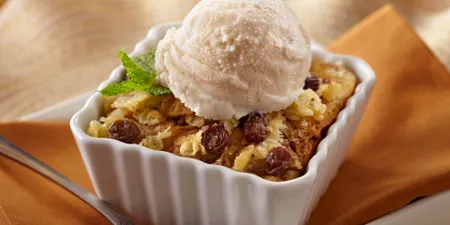
Ofenschlupfer
Recipes for bread pudding date back to medieval times, and are a frugal but delicious way to use up stale bread. This version is an easy-to-make German apple bread pudding. Rich with fruit and raisins, its flavor is reminiscent of apple pie. It is particularly tasty served with a high-quality vanilla ice cream or custard sauce.

Pastel de Nata
You can find these delicious little bites all over Portugal, and once you have tasted them beware, as they are addictive. Easy to make, the rich, eggy filling is pure comfort food. Here, we have simplified the recipe by using puff pastry dough for the shell. These are best eaten the day they are made, still warm from the oven.

Pumpkin Pie
No Thanksgiving table would be complete without a delicious pumpkin pie, with its trademark velvety texture and autumnal spices. Our version is served with creamy pumpkin gelato for an extra helping of seasonal cheer. Individual tart molds ensure that everyone can enjoy a taste of this holiday staple.

Sachertorte
Here is a version of the decadent Austrian classic, the eponymous Sachertorte (pronounced “SOCCER tort”) found in many of Vienna’s coffeehouses and originally served in Vienna’s Hotel Sacher. You can sample this on our ships, or try our delightful interpretation of this Viennese treasure at home. Just close your eyes, and you will hear the faint strains of a Strauss waltz.

Sirniki
A typical dish of Russia, this delightfully different dessert is made with fresh farmers’ cheese. In Ukraine, it is often served for breakfast, so you can try it for brunch too. The farmers’ cheese is very mild, and a good foil for topping it with strawberry ragout as below, but you could experiment with sour cream, jam, or applesauce.
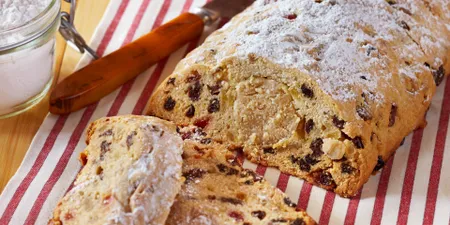
Stollen
Stollen is the classic German Christmas fruitcake: a rich yeast dough studded with nuts and dried fruit. This particular version uses raisins and candied fruit as well as marzipan. It is good served with butter and jam while still warm from the oven, and is also delicious days later toasted and topped with honey or preserves.

Strawberry Tart
This elegant dessert is a deconstructed tart that is enhanced by the subtle flavors of vanilla, strawberry, champagne and Specht Kirschwasser, a German clear cherry brandy.
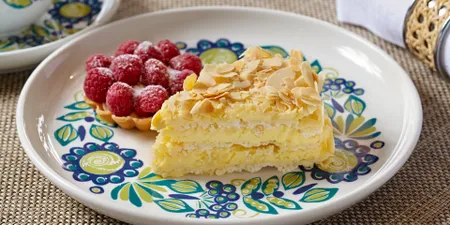
Suksessterte
In its native Norway, this gluten free “success tart” is a common sight at celebrations ranging from weddings to office birthday parties. Moist, fragrant almonds can be found both in the sponge and generously spread across the top and sides, making for a delectable dessert suitable for any occasion. When Norwegians settled in the Upper Mississippi region, they brought this taste of their homeland with them, and today this Norwegian culinary treat can be found in local bakeries throughout Wisconsin and Minnesota.

Swiss Cinnamon Stars
Cinnamon stars were first introduced into Swiss kitchens during the 1600s. Typically enjoyed at Christmas, these sweet treats incorporate ingredients that were once considered an expensive delicacy and are popular across all German-speaking countries.

Tarte Au Citron
This refreshing open-faced tart is similar in flavor to a lemon meringue pie without the meringue. It is usually dusted with powdered sugar to offset the tartness of the lemon. You can also top it with a few fresh raspberries for an elegant look, and should you want even more lemony flavor, add some lemon zest into the filling.

Twin Ginger Shortbread Cookies
If you love ginger, you will enjoy these rich shortbread cookies with both fresh and crystallized ginger. Chopped glazed walnuts add extra crunch, but regular walnuts can be substituted. Be sure to use a good-quality butter, as the flavor of it will come through. These are delicious with tea of any kind.

Viennese Crescent Cookies
These traditional cookies complement a cup of good, strong coffee. Stories would have you believe their crescent shape celebrates the defeat of the Ottoman Empire in Vienna, 1683. Whatever the origin, you will find them featured in bakeries throughout Vienna. This particular recipe calls for almonds, but you can substitute walnuts, hazelnuts or pecans—all equally delicious!
Drinks

Café Maria Theresa
Popular throughout Austria, this flavorful coffee is named for beloved Austrian empress Maria Theresa. And, this same recipe with a twist makes a Fiaker. That version, named for Vienna’s carriage drivers or fiakers, who need something warm to keep going in chilly weather, substitutes rum for the orange liqueur and omits the garnish.
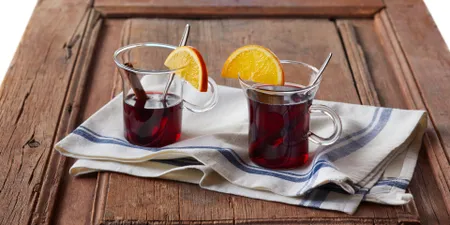
Glühwein
Around Christmastime, local holiday markets in the main squares and public houses in nearly every European town offer glühwein(hot mulled wine) as a delicious antidote to the season’s chill. To warm up on a stormy evening or put yourself in a celebratory mood, make your own at home. It is an easy, delightful way to share the holiday with friends.

Mississippi Sunset
With its eye-catching hue, this captivating cocktail calls to mind a dazzling sunset over the Mississippi River. Its pleasing blend of sweet and sour flavors makes it ideal for any occasion. Our recipe invites you to infuse the drink with your own creativity, choosing your favorite store-bought or homemade mix and liqueurs.

Rüdesheim Coffee
Hans Karl Adam, a German television chef, invented this delicious beverage to promote Asbach Uralt brandy—a famous German brandy dating back to 1892, and one of the best you will ever drink. The coffee is named after Rüdesheim am Rhein, Germany, a storybook village known for its vineyards, and is served in many of the local restaurants there.
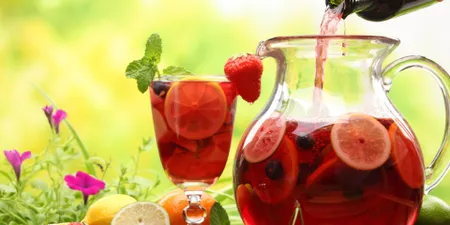
Sangria
The term sangria can be documented back to a punch enjoyed in London in 1736. The original ingredients included Madeira (a fortified Portuguese wine) sugar, lime juice, water and nutmeg. Over the centuries, the recipe has been modified, but it is still the classic preparation of wine and citrus fruit that makes sangria a favorite today.
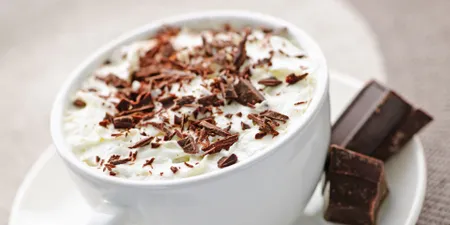
Viennese Hot Chocolate
Elevate humble hot cocoa to a decadent indulgence. This recipe is a bit more work than just opening a packet of instant cocoa, but so worthwhile. Melt high-quality chocolate into the milk and top it with real whipped cream, creating “slow food” that will bring a touch of the elegant Old World into your home.

White Lady
This refreshing gin cocktail with bright citrus notes was originally created by legendary bartender Harry MacElhone in 1919. This version was perfected by Highclere Castle’s charming butler and barman, Luis Coelho, using the estate’s namesake spirit—super-premium, award-winning Highclere Castle Gin.
Breakfast Dishes

Belgian Waffles
The Belgian waffle actually originated in North America, not Belgium. These are traditionally served with whipped cream and strawberries, but are also great with maple syrup and butter. Belgian waffle makers have deeper grids than a standard waffle maker, yielding a waffle that is bigger and fluffier with more space for whipped cream or syrup.

Russian Oladi
These are light, fluffy Russian pancakes made with kefir, a cultured sour milk. They are like plump little pillows, a bit tart, creating a nice contrast to a sweet topping. Chewier and less cakey than an American-style pancake, you can try them plain or with sour cream, fruit preserves or even a drizzle of condensed milk.

Sirniki
A typical dish of Russia, this delightfully different dessert is made with fresh farmers’ cheese. In Ukraine, it is often served for breakfast, so you can try it for brunch too. The farmers’ cheese is very mild, and a good foil for topping it with strawberry ragout as below, but you could experiment with sour cream, jam, or applesauce.
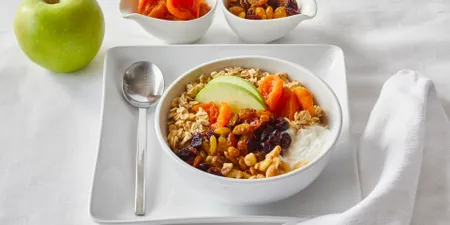
Viking Organic Muesli
Muesli, a common European breakfast, differs from granola in that it is made with raw—not toasted or cooked—grains. Oats are the base, and other grains, nuts and dried fruit are added. This recipe is great for experimenting; substitute buttermilk for the yogurt, almonds for walnuts, cranberries or dried apricots for raisins, or make other modifications to suit your taste.



